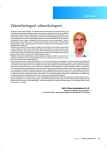Results of surgical treatment of proximal femur fractures in patients operated at the Traumatology Clinic of the Olomouc University Hospital (FNOL) in the years 2017–2019.
Authors:
MUDr. Lukáš Vinter 1,2; MUDr. Jan Kovařík 1; MUDr. Pavel Korpa 1
Authors‘ workplace:
Traumatologická klinika FN Olomouc
1; Ústav normální anatomie LF UP v Olomouci
2
Published in:
Geriatrie a Gerontologie 2020, 9, č. 4: 183-188
Category:
Review Article
Overview
Proximal femur (PF) fracture is one of the most common trauma diagnoses in geriatric patients.
The typical patient is a woman 80 years of age after having suffered a low-energy injury, typically a fall after tripping. The most common type of PF fracture in these patients is a pertrochanteric fracture. The patient’s prognosis depends mainly on the medical condition before the accident and age. The aim is to return the patient to the level of mobility before the accident as soon as possible with the least possible reduction in quality of life. The incidence, treatment costs and demands for aftercare capacity will increase.
Keywords:
fracture – proximal femur – complications – mortality – economic aspect
Sources
1. Bartoníček J, Džupa V, Frič V et al. Epidemiology and economic implications of fractures of proximal femur, proximal humerus, distal radius and fracture-dislocation of ankle. Rozhl Chir. 2008; 87(4): 213–219.
2. Douša P, Čech O, Weissinger M et al. Trochanterické zlomeniny femuru (Trochanteric femoral fractures). Acta Chir Orthop Traumatol Cech. 2013; 80(1): 15–26.
3. Čech O, Košťál R, Váchal J. Nestabilní pertrochanterické zlomeniny – jejich biomechanika, klasifikace a terapie. Acta Chir Orthop Traum Cech. 2000; 67:17–27.
4. Bartoníček J, Douša P, Skála-Rosenbaum J et al. Trochanterické zlomeniny. Úraz Chir, 2002; 10: 13–24.
5. Jong de L, Rijckevorsel van VAJIM, Raats JW et al. Delirium after hip hemiarthroplasty for proximal femoral fractures in elderly patients: risk factors and clinical outcomes. Clin Interv Aging. 2019; (14): 427–435.
6. Goldacre MJ, Roberts SE, Yeates D. Mortality after admission to hospital with fractured neck of femur: database study. BMJ. 2002; 325(7369): 868–869.
7. Džupa V, Bartoníček J, Skála-Rosenbaum J et al. Mortality in patients with proximal femoral fractures during the first year after the injury. Acta Chir Orthop Traumatol Cech. 2002; 69(1): 39–44.
8. Galler M, Zellner M, Roll C et al. A prospective study with ten years follow-up of two-hundred patients with proximal femoral fracture. Injury. 2018; 49(4): 841–845.
9. Müller F, Galler M, Zellner M et al. Comparative analysis of non-simultaneous bilateral fractures of the proximal femur. Eur J Trauma Emerg Surg. 2019; 45(6): 1053–1057.
10. Moore J, Carmody O, Carey B et al. The cost and mortality of hip fractures in centenarians. Ir J Med Sci, 2017; 86: 961–964.
11. Innocenti M, Civinini R, Carulli C et al. Proximal femural fractures: epidemiology. Clin Cases Miner Bone Metab. 2009; 6(2): 117–119.
12. Džupa V, Bartoníček, J. Rozbor souboru pacientů léčených v roce 1997 pro zlomeninu proximálního femuru – ekonomické aspekty léčení. Acta Chir Orthop Traum Cech. 1999; 66: 277–279.
Labels
Geriatrics General practitioner for adults Orthopaedic prostheticsArticle was published in
Geriatrics and Gerontology

2020 Issue 4
Most read in this issue
- Dysgeusia in the elderly
- Nutritional support. Part of complex care for geriatric patients
- Vascular acess in the elderly
- Psychometric validation of Czech version of the questionnaire Jacelon Attributed Dignity Scale.
